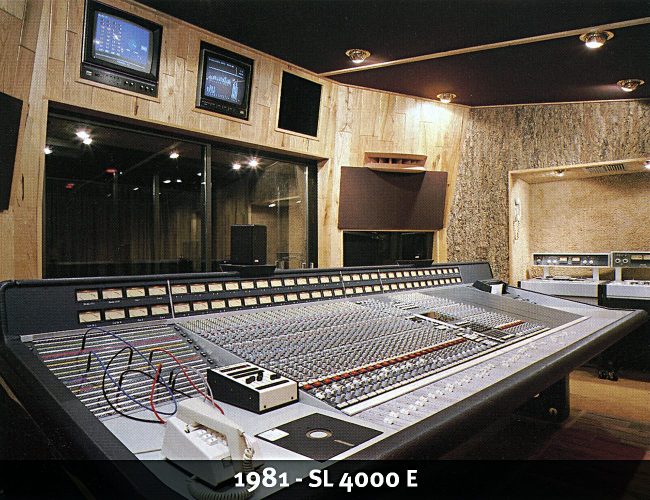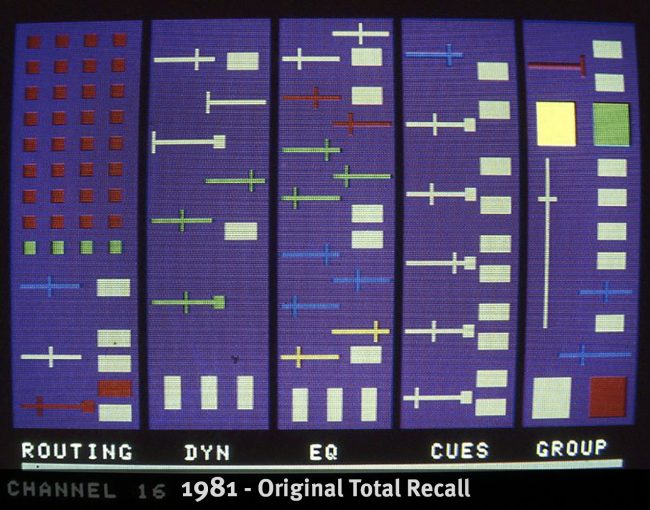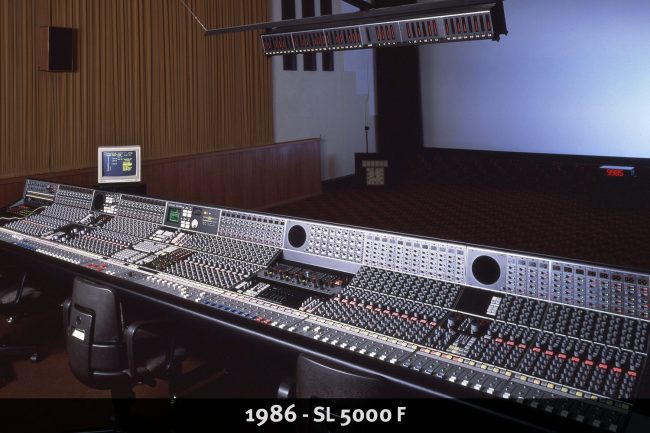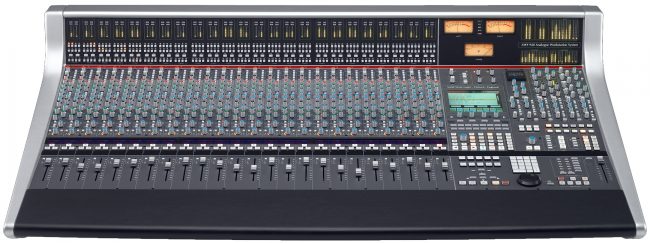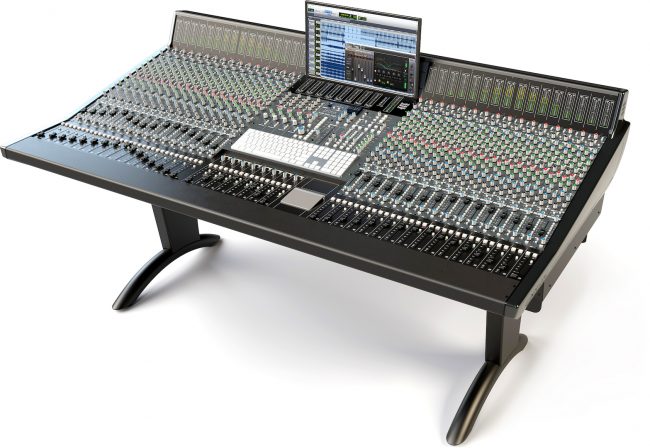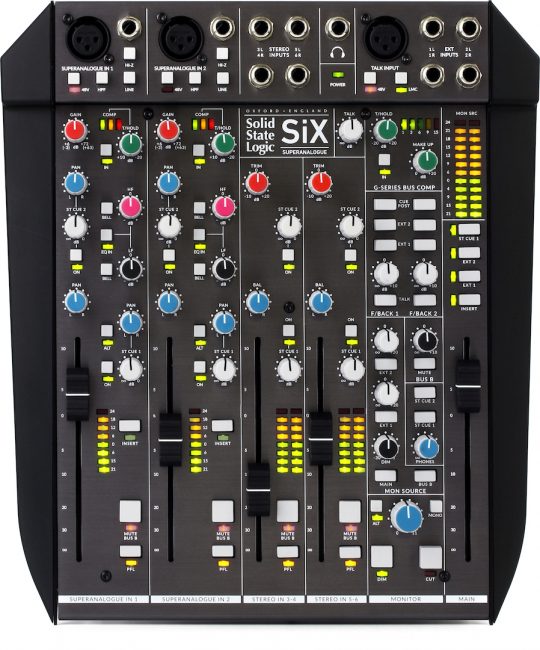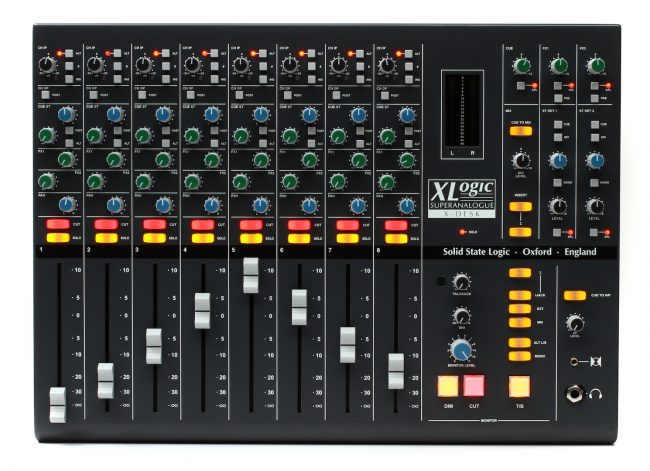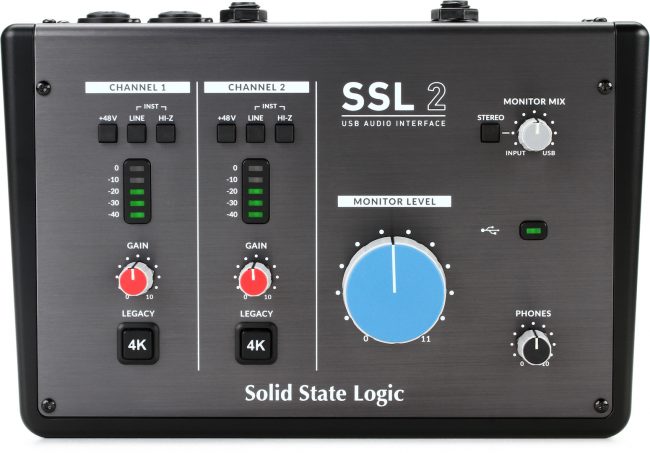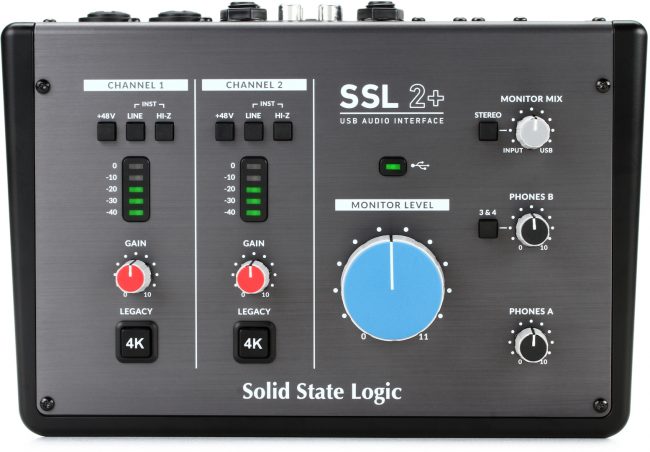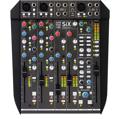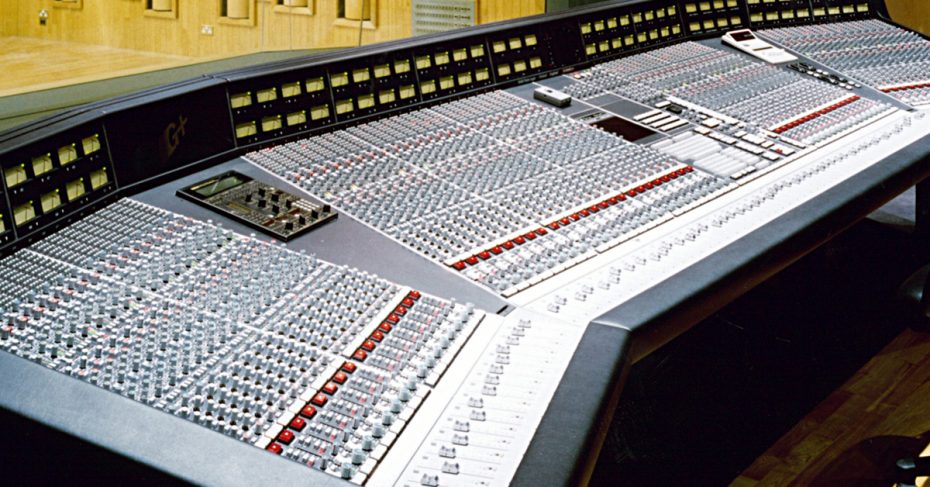
Historic images courtesy of Solid State Logic.
Established in 1969 by Colin Sanders, Solid State Logic initially manufactured FET switching systems for pipe organs. Sanders also owned a recording studio, for which he designed and built a console. SSL became a full-fledged console company with the introduction their SL 4000 B Series desk in in 1977. This was the era when Neve 80 Series consoles ruled the high-end studio scene. It was a tough market to crack: the Neves had a huge, authoritative sound that many producers, engineers, and artists were addicted to. SSL’s big breakthrough came in 1979 with the launch of the SL 4000 E Series. This console would transform the music business with its excellent sonics, flexible in-line architecture, per-channel dynamics, stereo bus compressor, Studio Computer with Total Recall, and more.
Bending the Board
Every console has a sound, and producers and engineers found that they could push SL 4000 Series boards into their yet-to-be storied sweet spot to achieve added punch and presence. A gain-staging strategy that became known among SSL aficionados as “bending the board,” this induced a lift on the top end and a subtle harmonic distortion that really brought mixes to life. Before the advent of moving faders, early 4000 E boards had a feature called VCA Trim, which allowed you to set the operating level of the board by adjusting gain and total harmonic distortion. Many engineers gauged how hard to push their program material by using the console’s Overload LED as a handy reference. As the icing on the cake, SSL’s famous 4000 Series bus compressor supplied the “glue” for that radio-ready sound that seemed to jump right out of the speakers.
Pure Genius
The genius of SSL’s 4000 Series lay in the brilliant way it addressed the challenges recording engineers faced in working with disparate pieces of gear (the console, outboard processors, and tape machines) that were not designed for tight integration. As a working engineer and studio owner, Sanders understood how this impeded the creative process, disrupting recording and presenting obstacles to experimentation during mixdown. So, he and his team not only designed 4000 Series boards with a compressor and a noise gate on every channel while cleverly exploiting the emerging, in-line console design trend by adding bus/tape switching and SuperCue monitoring, but they also integrated multitrack controls such as track-record arming into the control surface.
The Studio Computer
In the mid-1970s, Sanders and his business partner Paul Bamborough came up with the idea of using a computer to automate the console they’d built for Acorn Studios, which by that point had become SSL’s in-house recording facility. This led to the development of the SSL Studio Computer, which became an intrinsic design component of the SL 4000 B Series that was unveiled at the Paris AES show in 1977. As well as providing fader automation, the Studio Computer managed tape transport, enabling simple commands via dedicated keys, which would auto-locate the multitrack tape machine to user-specified locations in the program material with a preset pre-roll.
Total Recall
A later enhancement to the Studio Computer, Total Recall enabled the recording engineer to save and recall the settings of every pot and switch on every channel of the console, saving valuable studio time whenever mixes had to be reloaded (or “recalled”). The SL 4000 center section housed a video display unit and a QWERTY keyboard to interface with the computer. Total Recall allowed engineers to take a snapshot of the entire console, which was then stored on a 5.25″ floppy disk. This meant engineers and producers could take floppy disks of their project from one SSL-equipped studio to another — a feature that changed the industry by fueling the rise of the independent recording engineer (while, conversely, hastening the decline of the staff engineer).
SSL Conquers the Music Industry
Solid State Logic consoles took advantage of the latest analog electronics technology of the era and made extensive use of electronic switching to offer a generous range of routing options. Design engineers exercised great care to ensure that the controls of the EQ and dynamics operated across the most useful parts of their ranges, making it quick and easy for engineers to nail the sound they were after. Indeed, it was SSL consoles’ acclaimed ease of use (along with the integrated Total Recall automation) that is often cited as the main reason for their widespread adoption in the competitive professional-studio market. The result of feedback from their growing user base, G Series electronics eventually replaced the E Series, bringing requested changes to the equalization function as well as a host of overall performance improvements. By the mid-’80s, SL 4000 E and G Series boards had effectively elbowed out other console brands from the professional music studio market. For Solid State Logic, the time was ripe for a new conquest.
Hollywood Invasion
As large-format 4000 Series boards were taking over the music business, SSL was also designing smaller, purpose-built configurations for the broadcast market. In the mid-1980s, SSL’s 5000 F Series film consoles, derived from their SL 5000 B broadcast boards, began to replace the decades-old consoles on many Hollywood re-recording stages, introducing the film and television industry to console automation and a new level of audio fidelity. Until that point, many large post-production houses were still limping along on non-automated Quad Eight film consoles they had purchased new in the late ’60s or early ’70s.
Knowing it was time to rid themselves of these maintenance-intensive dinosaurs that were long past their prime, post-studio managers were receptive to Solid State Logic reps’ sales pitches highlighting the efficient workflow and return on investment that could be enjoyed if they purchased shiny, new SSLs. But the studios faced an uphill battle. Big-budget feature films and prime-time television shows were strictly union productions, and many of the established re-recording mixers on the union roster weren’t particularly motivated to learn an entirely new way of working. As ridiculous and counterproductive as this attitude seems today, console automation was dismissed in these circles as a passing fad!
Studio managers needed re-recording mixers who knew how to use the expensive consoles the studios had just purchased, so they turned to the music business, seeking to lure SSL-savvy recording engineers to Los Angeles with the dual seductions of hefty union pay and copious sunshine. To do this, they would have to sponsor new re-recording mixers by writing letters to the union explaining that these new recruits had “unique talents” that could not be supplied by existing union members. And so began an influx of music engineers into film and TV post. By the mid-’90s, SSL boards of all sizes — from massive, automated, three-mixer (dialog, music, and effects) consoles to small boards designed for ADR and Foley studios — proliferated all over Hollywood.
SuperAnalogue
Analog technology continued to evolve and took a further leap forward with the introduction of SSL’s SuperAnalogue design, first implemented in the SL 9000 J Series console of the mid-’90s. A combination of elements, including a DC-coupled (capacitor-free) signal path, contributed to the design’s extremely wide bandwidth and vanishingly low distortion. In spite of the fact that much of the bandwidth is well outside the audible range (or perhaps, because of it), the subjective performance of SuperAnalogue was exceptional for its time — and remains so to this day, even exceeding the capabilities of today’s state-of-the-art 192kHz converters.
The Legend Continues
SSL’s current analog console lineup — including Duality, AWS 924, AWS 948, XL-Desk, and Matrix2 — is based on SuperAnalogue circuitry. The first-generation AWS board, introduced in 2004, was the first to combine analog-console summing and processing technology with hardware DAW control in a single, streamlined user interface. Designed for modern, hybrid-studio workflows, so that a simple press of the Flip button will toggle the faders, the first row of rotary encoders, and the digital scribble strips between displaying/controlling the analog signal path and displaying/controlling your DAW’s mixer, this technology has been continually refined and remains at the core of SSL’s current music production range. Given how central studio integration was to their early console designs, DAW control is simply a natural evolution for SSL. Their current large-format consoles still feature transport control, motorized fader automation, and Total Recall.
Back to the Origin
If you track in your studio (or aspire to), you should know about the SSL Origin. Equipped with the company’s new PureDrive preamps, the E Series 4-band parametric EQ, and the legendary stereo bus compressor, the 32-channel Origin studio console brings the classic SL 4000 sound and workflow to a new frontier of affordability. The Origin delivers the analog warmth largely absent from purely digital recordings while seamlessly integrating into your DAW workflow. It complements each stage of production, injecting vitality into digitally recorded tracks on the front end while delivering the punch, spaciousness, and depth of analog summing in post production.
SSL for the Project and Home Studio
In light of SSL’s illustrious professional-console legacy, it’s gratifying to note that today the company makes products for studios of all sizes. From the X-Desk SuperAnalogue mixer and Nucleus 2 DAW controller to the SiX desktop mixer, there’s something for everyone. Take the SiX, for example. At first glance, it may look like other compact desktop mixers, but a closer look will reveal its large-format console lineage. Combining a 6-channel analog mixer with two SuperAnalogue mic preamps and 12 line inputs during mixdown, two mono recording channels, two stereo line channels, two cue buses, and G Series master bus compressor, SiX gives you a flexible, intuitive feature set designed to accommodate any creative workflow.
SSL Interfaces
When SSL came out with their first audio interfaces, needless to say, we perked up. Boasting ruler-flat frequency response, the SSL2 (2-in, 2-out) and SSL2+ (2-in, 4-out) USB audio interfaces come with two pristine microphone/line/instrument preamps, class-leading 24-bit/192kHz converters, and a switchable 4K circuit that imparts the legendary SL 4000 tonality that launched a thousand Grammys. Solid State Logic has been one of the dominant forces in audio recording for over four decades, and the chance to outfit your home studio with that iconic sound is very exciting, indeed!
The SSL Native Complete Bundle
A powerful suite of plug-ins designed to meet the company’s exacting standards, the SSL Native Complete Bundle brings classic Solid State Logic processing to your DAW. The engineers at Sweetwater are impressed by how accurately these plug-ins capture the character of their analog counterparts. From detailed emulations of the renowned E and G Series equalizers and SSL’s celebrated bus compressor to application-specific channel strips and creative processors, the SSL Native Complete Bundle has everything you need to make your mixes radio ready.
Full Circle
When Colin Sanders established Solid State Logic in 1969, he had no way of knowing if his company would still be in existence a half century later. Sadly, Mr. Sanders died at the age of 50 in a tragic helicopter crash. The company he founded would go on not only to dominate the recording and film post industries, but also to be the only successful large-format console manufacturer to make the jump into the project/home studio market with products that integrate the analog and digital processes intrinsic to modern-day music production. Over 50 years on, Solid State Logic is doing quite well — and we’re so much better for it!


